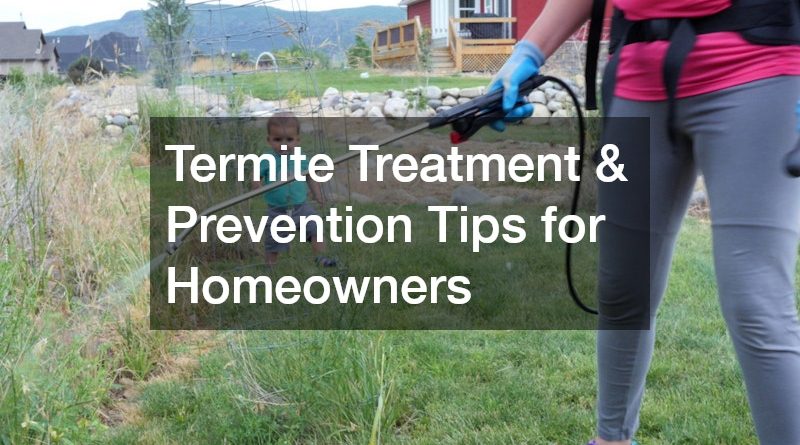Termite Treatment and Prevention Tips for Homeowners
Termites are among the most destructive pests facing Australian homeowners. Known for causing extensive structural damage, these silent invaders can compromise timber-framed properties without any obvious signs until the damage is done. Protecting your home involves a combination of proactive strategies, regular inspections and targeted interventions. With the right knowledge and support, like termite treatment, homeowners can guard their property against these costly pests.
Understanding Termite Behaviour & Risk
Termites feed on cellulose, which is found in wood, paper and some fabrics. Their constant search for food drives them into homes, particularly through cracks in foundations, gaps in flooring or direct soil-to-wood contact.
Because they often work within walls or under floors, infestations can go unnoticed for months or even years.
Homes constructed with timber are particularly vulnerable, especially if they are surrounded by dense vegetation, woodpiles or have poor drainage. Even homes made of brick or concrete are not immune, as termites can still enter through small structural weaknesses or build tunnels to reach interior wood.
Signs of Termite Activity & Damage
Spotting the signs of termites early can make all the difference. Common indicators include timber that sounds hollow when tapped, cracks in paint or plaster that appear without an obvious cause, and the presence of mud tubes along external walls or foundations. You may also notice discarded wings near windowsills or doors, or detect warped doors and sagging floors that weren’t previously present. Because these symptoms can resemble other types of structural wear, it’s often necessary to engage a professional to confirm whether termites are the cause.
Practical Prevention Tips & Habits
While complete elimination of risk isn’t possible, homeowners can take several practical steps to significantly reduce the chance of infestation. One simple yet effective habit is maintaining a clear perimeter around the home. Avoid placing mulch, firewood or untreated timber in direct contact with the house, and keep gardens or stored items at least 30 cm away from the foundation to discourage termite access.
It’s also important to fix leaks as soon as they appear. Termites are attracted to moisture, and conditions created by leaking taps, gutters or downpipes provide an ideal environment for them to thrive. Making sure the home is properly drained helps reduce this risk.
Another useful strategy is sealing gaps and entry points. Cracks in concrete slabs, gaps in flooring or walls and other small openings can all serve as hidden entryways for termites. Ensuring these are sealed limits access and strengthens the home’s natural defences.
Regular inspections are also key. Licensed pest inspectors have the training and tools to spot the early signs of termites, many of which are not obvious to the untrained eye. Scheduling an annual inspection can detect potential issues before significant damage occurs.
When to Consider Professional Treatment
If termite activity is suspected or confirmed, professional help is essential. Attempting to handle an infestation without the right tools or expertise can often make the problem worse. Licensed pest controllers use targeted solutions that not only eliminate active colonies but also protect against reinfestation.
The most effective termite treatment approaches depend on the extent of the problem, the type of construction and site conditions. Options may include baiting systems, soil treatments or direct wood applications. Professionals can also offer advice tailored to your property layout and risk level.
Engaging a pest control specialist also ensures compliance with relevant Australian standards, offering peace of mind that the issue has been dealt with correctly.
Long-Term Strategies & Home Maintenance
Ongoing vigilance is key to protecting your home from termites. Incorporating termite prevention into your regular home maintenance routine is far less costly than repairing damage after the fact.
Inspect wooden fencing, garden beds and outbuildings regularly. Consider replacing untreated timber with termite-resistant alternatives where feasible. Keep gutters clean and ensure water is directed away from the home’s foundation. Even small changes like using steel stirrups for deck posts can reduce the risk of termites accessing timber from the ground.
Communication is also vital if you’re in a strata or shared property arrangement. Ensuring all parties are aware of maintenance responsibilities and inspection schedules helps prevent gaps in protection.
Working With Trusted Professionals & Services
Choosing the right pest control provider is an important decision. Look for licensed professionals with experience in termite management. Seek out providers who offer detailed assessments and clearly explain their recommended approach.
It may also help to ask for references or read reviews to get a sense of their reliability and quality of service. A reputable provider will take time to answer your questions and provide a written plan before any work begins.
Termites pose a serious threat to Australian homes, but with the right strategies, the risk can be managed. Awareness, good property maintenance and early detection all play a role in minimising potential damage. While DIY measures help reduce risk, a professional termite treatment plan provides the strongest safeguard against infestation and the costly repairs that often follow.
Investing in ongoing protection is not just about maintaining the value of your home; it’s about preserving safety, comfort and peace of mind. By taking action today, you can help ensure your property remains strong and termite-free well into the future.

